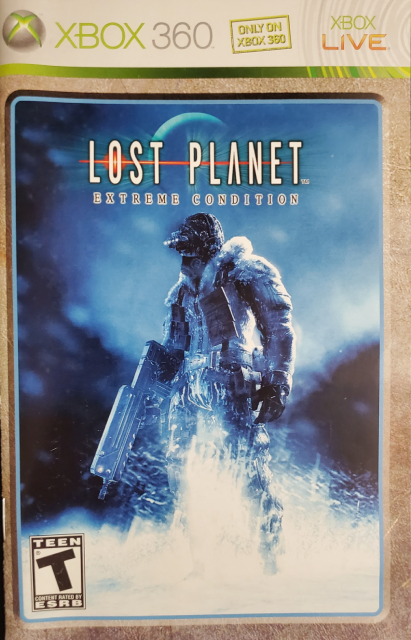Lost Planet Review: About as Consistent as a Snow Day
• View original
This article was originally published in the February 21st, 2007 issue of Suffolk County Community College's student newspaper, Compass. It has been transcribed here for archival purposes. To learn more about the making of this article, click here.
Lost Planet: Extreme Condition couldn’t have been more aptly named. In many ways, Capcom’s latest epic takes some big steps forward in design, plot, and presentation. But in other ways, the game pulls a 180, and dredges up some artifacts of gaming that were thought to be long dead. Thankfully, the things that Lost Planet does right are far more numerous than the things the game does wrong, which in the end leaves us with a game that’s certainly not perfect, but still manages to be plenty of fun.
The game takes place on a cold wasteland of a planet, EDN III, which was colonized by humans over a century ago after the Earth became uninhabitable. After arriving, the colonists soon came under attack from the Akrid, a hostile alien life form which seems hell-bent on eradicating all human life on the planet. Ironically, it’s from these enemies that the humans find a plentiful source of the most precious energy on the frozen planet- thermal energy.
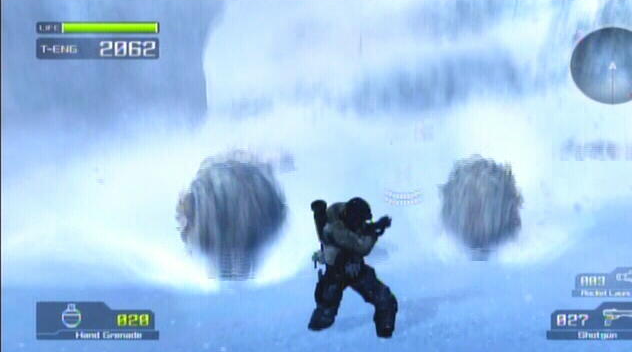
The main plot focuses around Wayne, a young VS suit (or giant mech) pilot, who combats the Akrid alongside his father- also a VS pilot. One day, Wayne’s team is ambushed by a giant Akrid called the green eye, who kills Wayne’s father and almost wipes out him as well. Fortunately, Wayne survives and is taken in by a group of new-age exterminators determined to rid the world of the Akrid, one nest at a time. From then on, the plot dulls somewhat. Wayne spends the game seeking out the Akrid’s hives, trying to hunt down the green eyed monster that killed his father, and unravel the sinister plot hidden deep underneath the frozen tundra. Oh, and he’s got amnesia. This is where Wayne’s recessive Matrix-Shenmue gene kicks in, and he transforms into a teenage surfer on a quest to avenge his father’s death. Needless to say, we’ve all seen more original main characters before.
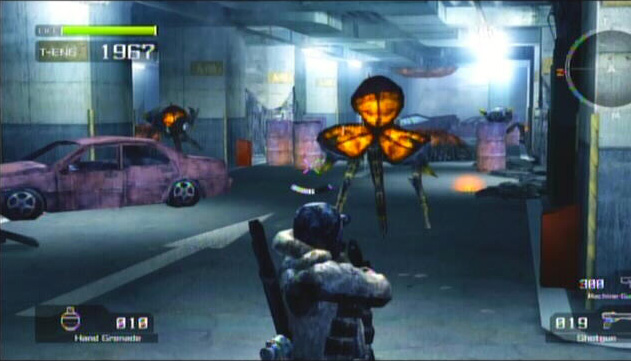
Between the cheesy cut-scenes and dialogue lies the gameplay- and this is one of the aspects of Lost Planet that is truly unique. In lieu of managing a traditional health bar, Wayne’s stamina is managed through a constantly ticking timer of thermal energy, which is what keeps Wayne warm enough to survive the frozen bitterness. If the energy reading reaches zero, you’ll flat line, and it’s game over. Thermal energy can be replenished by downing enemies, as well as by destroying any of the game’s impressive variety of destructible objects. For such a bland and expansive wasteland, there sure seems to be plenty of things to smash- especially once you take control of a VS suit. Some items are even buried underground, and can be dug out for Wayne to use. There’s plenty of weaponry at your disposal, whether on foot or in a VS. Machine guns, shotguns, grenades and rocket launchers- all the standard fare is present and accounted for, and what’s more are scattered plentifully throughout each level. On top of that is your gatling gun, which works how you’d expect Batman’s Batarang to- you launch the line toward any solid object, it latches and pulls you in, and you take a leap up for good measure. It functions well on almost any surface, and adds some nice flexibility to Wayne’s otherwise sluggish movements (where’s a dash button when you really need one?). It also helps prevent cheap deaths from falling off of cliffs, which is easy since the outdoor terrain is basically one color.
You can also attach and remove weapons from the VS suits, which adds a nice little custom touch to the gunplay. I just wish I could paint the suits a different color; the entire palette of colors in Lost Planet runs the gamut from white, to black, to reddish orange when things blow up… and that seems to be about it. While the levels are expansive and the graphics are crisp and detailed, the monotonous layout of each stage- snow, warehouse, snow, cave, snow- gets a bit tedious after a while. The audio is equally crisp and a bit more impressive at times, especially during cut-scenes and the massive boss battles. In-game music is a bit hard to come by, however, which only adds to the tedium of the navigating the arctic terrain.
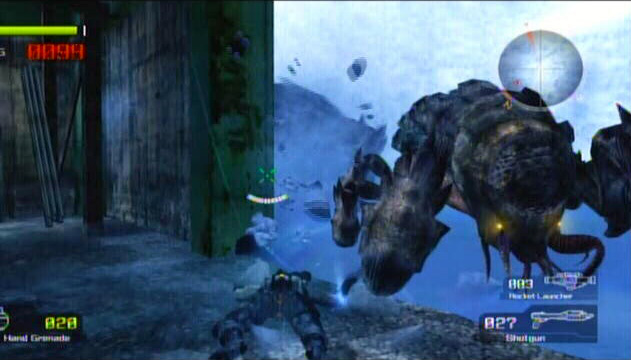
Another issue that needs addressing is the game’s camera and control problems. Once considerable obstacles for designers during the dawn of 3D gaming, they have at this point been boiled down to a pure science. Even mediocre games don’t seem to have a problem in this area- so long as they stick to the tried-and-true Halo/GoldenEye/Half-Life formula (depending on which game you think invented the modern shooter first). And yet Lost Planet’s control scheme seems to have been pulled right out of a first generation Dual Shock title, replete with 90-degree turn shoulder buttons.
Capcom still kept the traditional dual analog stick layout for movement and aiming- but instead of having the right thumbstick controlling the camera directly, it controls a reticule in the center of the screen. The reticule can drag Wayne’s view around in any direction, but there’s a dead zone in the center, which means unless the object you’re aiming at is in that gray area in the center of the screen, you’d better have fast thumbs. It feels like an unholy union between System Shock and Space Harrier at first, but it certainly doesn’t break the controls. In fact, it accommodates the heavy feel of the mech combat quiet nicely, but it certainly does hamper them when on foot. I wonder why Capcom decided to make human combat as slow and unwieldy as mech combat. Does Wayne have a lazy eye? Are those goggles the wrong prescription? I guess we’ll never know- but in the inevitable sequel (Found Planet?), I really hope Capcom smoothes out this wrinkle in an otherwise smooth control scheme.
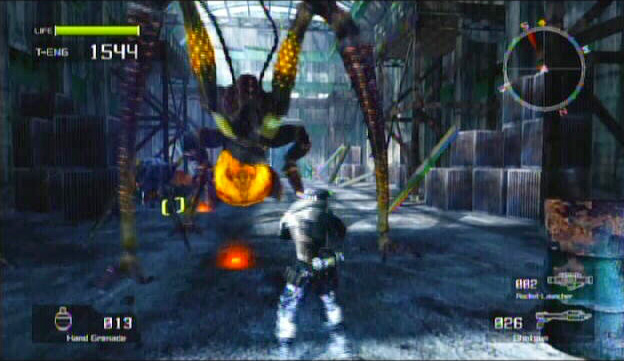
Although Lost Planet takes some steps back in the gameplay department, it takes several more forward as well. The checkpoint system is actually very ingenious, with large tripods set up throughout each level which, once activated, provide you with a map as well as a light pointing toward the next goalpost. In a game whose levels are so monotonous, these posts come in mighty handy. Another interesting decision by Capcom was to map the pause buttons and inventory/map buttons separately- this means that when you check your map or your status, you thermal meter continues to decrease, just as it normally would. It’s a bit unusual, but it really does make sense, considering that time doesn’t freeze in real life when you ask Tom-Tom where the nearest KFC is (at least, not with the one I have). The menu system, loading screens, and interface are also well polished and smartly designed, and it’s the little touches like these that show a lot of thought has been put into polishing the game’s dynamics- which makes the 32-bit control scheme all the more befuddling.
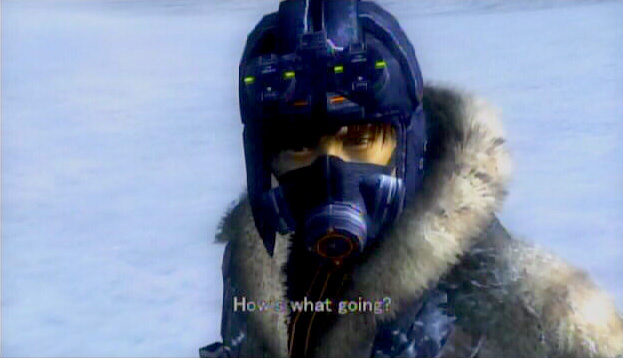
Speaking of the PS1 era, I couldn’t help but wince nostalgically at some of Lost Planet’s cut-scenes. This is also another area in which the game just can’t pick a side. The opening cinematic is actually pretty riveting, with enough style and production quality to easily make up for the voice acting, which certainly varies at times. But after that, the game switches to in-engine cut-scenes whose jerky character animations and uneven voices harks of the typical cinematic moment found in a Dreamcast game.
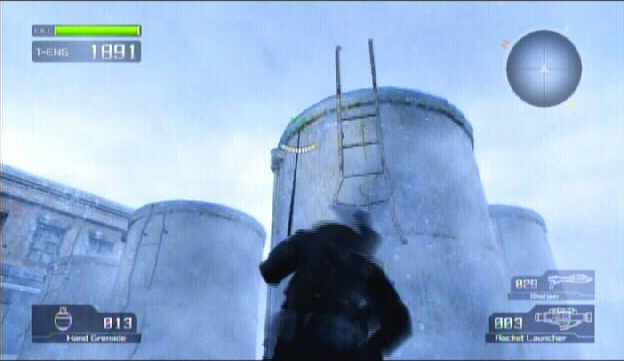
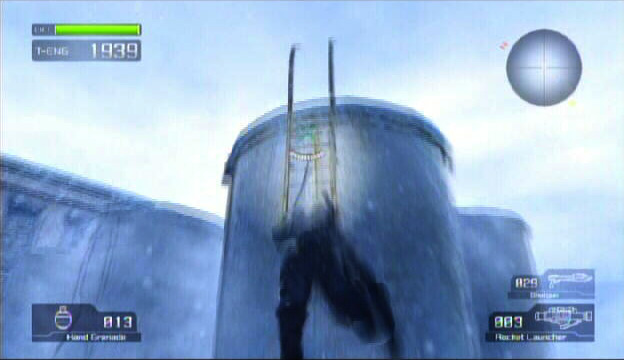
As far as multiplayer is concerned, there’s a 16-player online feature with the standard Xbox Live system in place- although no split-screen or even system link, which will surely bum out the LAN party crowd. Nonetheless, the online play is smooth and, like the single player mode, offers a unique twist on the typical shooter gameplay mechanic. Rather than the traditional variety of deathmatches, online competitions are instead played as capture-the-flag style events, with checkpoint posts acting as bases to be captured and fought over.
Between stomping an opponent in a VS suit and flying up a building wall with the gatling gun, playing Lost Planet online is truly one of the most original experiences available on Xbox Live today, and a hell of a lot of fun. Think MechAssault meets Team Fortress, and you’ll start to get a clearer picture.
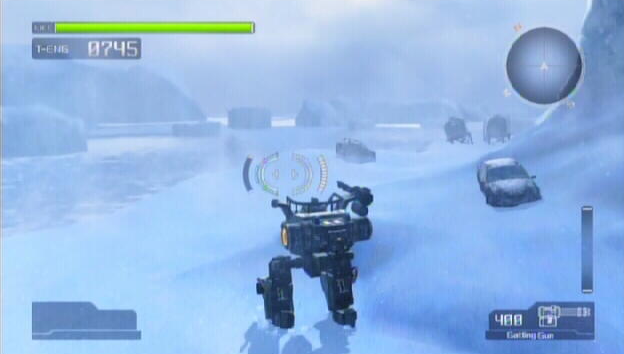
Lost Planet: Extreme Condition is a game with a very strange identity crisis: it knows exactly what it wants to be, but it doesn’t always know how to be it. There are some head-scratchingly poor decisions on Capcom’s part, for sure- but they’re so spread out amongst an overall solid game that you’ll likely forgive most of this game’s strange quirks, and enjoy a gameplay experience that is unique, fun, and most importantly (in accordance with the mandatory one winter weather pun law,) won’t leave you out in the cold.
